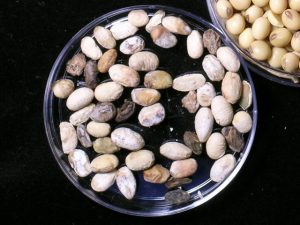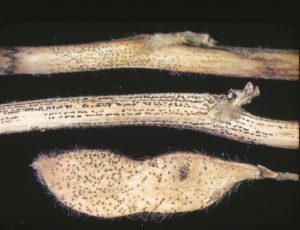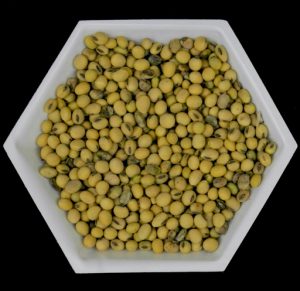Poor Soybean Seed Quality and Preparing for the 2019 Field Season
Damon Smith, Associate Professor and Extension Specialist, Department of Plant Pathology, University of Wisconsin-Madison
Shawn Conley, Professor and Extension Specialist, Department of Agronomy, University of Wisconsin-Madison

Figure 1. Severe Phomopsis seed decay. Photo Credit: Craig Grau, University of Wisconsin-Madison.
As we finish off 2018 and look ahead to the 2019 planting season, soybean farmers need to be prepared for some potential seed quality issues. The 2018 crop was plagued by several problems, but one of the most substantial was a large amount of white, chalky, or black, and damaged seed (Figure 1). This damaged seed is impacting germination rates of soybean seed slated for the 2019 crop.
What caused this issue?
Most of this damage is a result of infection and colonization by a group of fungal species called Diaporthe. This group is implicated in diseases such as stem canker, pod and stem blight (Figure 2), and Phomopsis seed decay (Figure 3). Excessive rains at the end of August and throughout September and October resulted in a large amount of pod infection by Diaporthe. These infections combined with delayed harvest allowed for extensive seed colonization by these fungi. This resulted in Phomopsis seed decay which has led to visually damaged seed and the germination issues we are now seeing. To learn more about this group of fungi and the diseases they cause, visit the Crop Protection Network (CPN) website on pod and stem blight and Phompsis seed decay by clicking here. You can also download a PDF version of the CPN fact sheet on the same subject by clicking here.
How Do I manage this Problem at Planting in 2019?

Figure 2. Pod and stem blight of soybean
Soybean seed producers should try to clean seed to achieve less than 20% damaged seed in a seed lot. Multiple cleaning steps might be needed to achieve this level. While testing germination now is recommended, remember that testing germination again next spring and potentially just prior to delivery will also help you to understand the germination rate and determine if other management strategies need to be employed such as fungicidal seed treatments.
Seed treatments can help improve the germination rate of seed damaged by Diaporthe. However, you will need more than metalaxyl or mefonoxam active ingredients in your seed treatment. Metalaxyl and mefonoxam are good against Phytophthora and Pythium, but not effective against other organisms, like Diaporthe. Seed treatments with Phomopsis on the label have an additional fungicide (either a DMI or SDHI). Page 157 of the publication A3646 – Pest Management in Wisconsin Field Crops has a table of some of the seed treatments with Phomopsis on the label. Also available is the seed treatment efficacy table from the Crop Protection Network (CPN). You can download that publication by clicking here.

Figure 3. Damaged soybean seed as a result of Diaporthe infection.
We also recommend that as a farmer, you double check the percent germination on every seed lot prior to planting and adjust your seeding rates accordingly. Here are our recommendations for soybean seeding rate based on yield potential and white mold risk: The Soybean Seeding Rate Conundrum.
If I’m a Seed Producer, What Should I Do to Prevent this Problem Next Year?
Foliar fungicide applications during the growing season could reduce the damage from Diaporthe. Some work has demonstrated that fungicide applications between the R3 to the R5 growth stages might be useful in reducing damage. This might help improve seed quality, but not necessarily improve yield. For a list of fungicide products with efficacy ratings for soybean, take a look at this additional publication from the CPN by clicking here.





